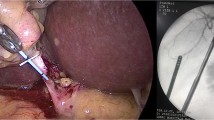Abstract
Background/purpose
Transgastric access is a major route in natural orifice translumenal endoscopic surgery (NOTES); gastrotomy should be performed unless it would damage surrounding organs in the peritoneal cavity. This article describes a novel rendezvous gastrotomy technique over a direct percutaneous endoscopic gastrostomy (PEG).
Methods
In six live porcines, the gastrotomy involved applying a direct PEG through the abdominal wall into the stomach and exchanging to a needle trocar. An endoscopic balloon catheter was passed through the trocar by rendezvous technique. Then the inflated balloon and endoscope were advanced to the peritoneal cavity through the gastrotomy. Transgastric cholecystectomy was performed with a hybrid needle grasper through the same percutaneous site and the gastrotomy was closed with endoscopic clips.
Results
The rendezvous gastrotomy technique could reduce guidewire exchange. The success rate was 100% (6/6). Mean times for transgastric peritoneoscopy and cholecystectomy were 25.5 and 83.5 min. Mortality and morbidity was 0%. The addition of the extra trocar was unnecessary in all procedures.
Discussions/conclusions
The advantage of this introduction system includes the creation of controlled gastric perforation, which is easier to close. It provides reliable transgastric access and increases safety. It simplifies transgastric NOTES and provides less invasive hybrid NOTES procedure.







Similar content being viewed by others
References
Kalloo AN, Singh VK, Jagannath SB, Niiyama H, Hill SL, Vaughn CA, et al. Flexible transgastric peritoneoscopy: a novel approach to diagnostic and therapeutic interventions. Gastrointest Endosc. 2004;60:114–7.
Sugimoto M, Yasuda H, Koda K, Suzuki M, Yamazaki M, Tezuka T, et al. Evaluation for transvaginal and transgastric NOTES cholecystectomy in human and animal natural orifice translumenal endoscopic surgery. J Hepatobiliary Pancreat Surg. 2009;16(3):255–60.
Sporn E, Miedema BW, Astudillo JA, Bachman SL, Loy TS, Davis JW, et al. Gastrotomy creation and closure for NOTES using a gastropexy technique (with video). Gastrointest Endosc. 2008;68:948–53.
Marks JM, Ponsky JL, Pearl JP, McGee MF. PEG “Rescue”: a practical NOTES technique. Surg Endosc. 2007;21:816–9 (review).
McGee MF, Marks JM, Onders RP, Chak A, Rosen MJ, Williams CP, et al. Infectious implications in the porcine model of natural orifice transluminal endoscopic surgery (NOTES) with PEG-tube closure: a quantitative bacteriologic study. Gastrointest Endosc. 2008;68:310–8.
Pauli EM, Moyer MT, Haluck RS, Mathew A. Self-approximating transluminal access technique for natural orifice transluminal endoscopic surgery: a porcine survival study (with video). Gastrointest Endosc. 2008;67:690–7.
Rattner D, Hawes RH. ASGE/SAGES Working Group on Natural Orifice Translumenal Endoscopic Surgery White Paper October 2005. Gastrointest Endosc. 2006;63:199–203.
Ko CW, Kalloo AN. ASGE/SAGES Working Group on Natural Orifice Translumenal Endoscopic Surgery White Paper October 2005. Surg Endosc. 2006;20:329–33.
Reddy DN, Rao GV. Transgastric approach to the peritoneal cavity: are we on the right track? Gastrointest Endosc. 2007;65:501–2.
Gauderer MVRL, Ponsky JL, lzant RJ. Gastrostomy without laparotomy: a percutaneous endoscopic technique. J Pediatr Surg. 1980;15:872–5.
Taylor CA, Larson DE, Ballard DJ, Bergstrom LR, Silverstein MD, Zinsmeister AR, et al. Predictors of outcome after percutaneous endoscopic gastrostomy: a community-based study. Mayo Clin Proc. 1992;67:1042–9.
Mamel JJ. Percutaneous endoscopic gastrostomy. Am J Gastroenterof. 1989;84:703–10.
Russell TR, Brotman M, Norris F. Percutaneous gastrostomy. A new simplified and cost-effective technique. Am J Surg. 1984;148:132–7.
Miller RE, Castlemain BN, Lacqua FJ, Kotler D. Percutaneous endoscopic gastrostomy. Surg Endosc. 1989;3:186–90.
Rabaneck L, Wray NP, Petersen NJ. Long-term outcome of patients receiving percutaneous endoscopic gastrostomy tubes in the Department of Veterans Affairs medical system. Gastroenterology. 1994;106:A23.
Manes G, Baratti C, Ardizzone S, Ferla F, Spiropoulos J, Corsi F, et al. Over-the-catheter precut to gain access to the biliary duct during ERCP rendezvous. Surg Endosc. 2008;22:2323–5.
Dickey W. Parallel cannulation technique at ERCP rendezvous. Gastrointest Endosc. 2006;63:686–7.
Elmunzer BJ, Schomisch SJ, Trunzo JA, Poulose BK, Delaney CP, McGee MF, et al. EUS in localizing safe alternate access sites for natural orifice transluminal endoscopic surgery: initial experience in a porcine model. Gastrointest Endosc. 2009;69:108–14.
Fritscher-Ravens A, Ghanbari A, Cuming T, Kahle E, Niemann H, Koehler P, et al. Comparative study of NOTES alone vs. EUS-guided NOTES procedures. Endoscopy. 2008;40:925–30.
Sugimoto M. Natural orifice translumenal endoscopic surgery (NOTES) for Innovation in hepatobiliary and pancreatic surgery: preface. J Hepatobiliary Pancreat Surg. 2009;16(3):247–8.
Author information
Authors and Affiliations
Corresponding author
About this article
Cite this article
Sugimoto, M., Yasuda, H., Koda, K. et al. Rendezvous gastrotomy technique using direct percutaneous endoscopic gastrostomy for transgastric cholecystectomy in hybrid natural orifice translumenal endoscopic surgery. J Hepatobiliary Pancreat Surg 16, 758–762 (2009). https://doi.org/10.1007/s00534-009-0143-1
Received:
Accepted:
Published:
Issue Date:
DOI: https://doi.org/10.1007/s00534-009-0143-1




